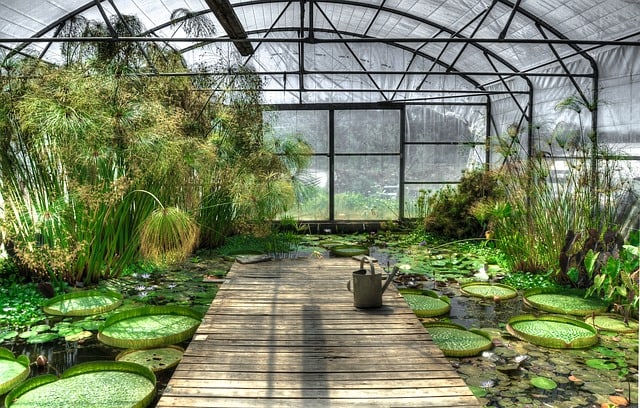This article discusses the green credentials of Greenhouses. Do they make environmental sense in a domestic setting and what are the factors that alter their ‘greenness’?

The Butterfly Effect
Relatively small changes, when made by thousands of people, add up to have a large effect. In terms of greenhouse gas reduction this is especially true. The increasing popularity of environmentally friendly homes, the so-called green homes, is a prime example of people thinking globally but acting locally. These homes choose materials with a low carbon footprint and their design ensures that their inhabitants have a much smaller carbon footprint than they would have done in a ‘normal’ house.
Green Home Fundamentals
Eco-homes invariably have extremely efficient thermal insulation often along with low-energy heating systems such as heat-pumps. The harnessing of natural energy is also given a high priority and this includes solar panels, wind turbines and geothermal systems. Simple design considerations such as employing large glazed areas on elevations receiving the most direct sunlight and smaller windows on more shady aspects help to maximize the use of solar radiation which reduces energy consumption.
Careful management of water usage including rainwater, reduce the environmental impact of the inhabitants (and save money). Rainwater capture can also help to reduce land erosion and flood risks.
The truly “green” house will also be built in the most low-impact manner possible. Sustainable materials are usually specified with local goods being favoured over those involving extensive transportation due to the energy required to move materials. Of course anyone going to the trouble and expense of building a green home will want to carry these principles across to their cars, rubbish disposal and of course their gardens.
Greenhouses
Greenhouses are not generally built with environmental concerns in mind, their design focuses on their function as a plant house. Levels of thermal insulation can never come close to those found in modern houses and heating systems, where fitted, are most often inefficient and polluting. So does the greenhouse have any worthwhile green credentials?
The answer, rather surprisingly, is yes! The first and most obvious reason is that greenhouses are designed to be renewable energy capture systems – the sun shines, the temperature inside the greenhouse rises thanks to a completely free and pollution-free natural heating system. Controlling the internal temperature can also be done easily and this often simply involves the opening and closing of vents. In better quality greenhouses, this operation is performed automatically.
Hot Houses
Some greenhouse owners simply use their buildings to take advantage of the sun’s energy in this way and make no provisions for greenhouse heating. Such a greenhouse is usually referred to as a cold house even though its summertime temperatures are far from being cold. Many gardeners prefer to provide some level of heating turning the greenhouse into a cool house, warm house, hot house or even a stove house depending on the temperatures chosen.
Paraffin or Kerosene Greenhouse Heaters
For a small domestic greenhouse, the choice is usually limited to heating with a paraffin (or kerosene) stove or by electricity. Paraffin is a fossil fuel and it also gives off some nasty compounds when burnt (like nitrogen oxides and sulfur dioxide amongst others). It also produces carbon dioxide which is of course a greenhouse gass. It should be noted that although it produces more CO2 than natural gas it produces less than coal or wood.
It does have some advantages however and is cheap, readily available and useful where the greenhouse is a long way from an electric supply. When used in a closed greenhouse, it produces high levels of humidity which is sometimes an advantage and at other times a disadvantage. The carbon dioxide produced acts as a powerful growth stimulant and is readily taken up by plants inside the greenhouse.
Electric Greenhouse Heaters
Electric heating is usually the preferred option and this is much more easily and accurately controlled. The emissions of the electricity used of course depend on the source of the electricity used. Although often considered to be expensive, an eco-home may be able to offset these costs by using a battery bank to store electrical power produced from renewable energy generators.
Greenhouse Materials
Top quality greenhouses often offer significantly improved thermal efficiency and additional insulation is sometimes provided for the coldest times of year. If you want a greenhouse with good environmental credentials then choose one with double glazing standard glass as well as a quality build that does not air leak round the glass panes or door mechanism.
Most greenhouses rely largely on aluminum in their construction and, although its production involves high energy usage, it is often made using hydro-electric power helping reduce its carbon footprint. Of course hydroelectric power schemes often have their own detrimental environmental impacts which could damage hydroelectric powers green credentials. The other main alternative is a wooden structure. Any woods used should be from sustainable sources and ideally treated in some way to extend their life exposed to the elements. Untreated softwoods are not usually recommended as they warp, expand and shrink reducing the strength and thermal insulation properties of the structure.
So a greenhouse does have a place in the garden of an eco home however a careful analysis of the materials used to build it and the heating system it uses (if any) needs to be carried out. It is highly unlikely you are going to be able to source an environmentally friendly greenhouse at the budget range of the market. However higher end greenhouse manufacturers using the latest materials and machining techniques will offer a much more eco friendly building.

